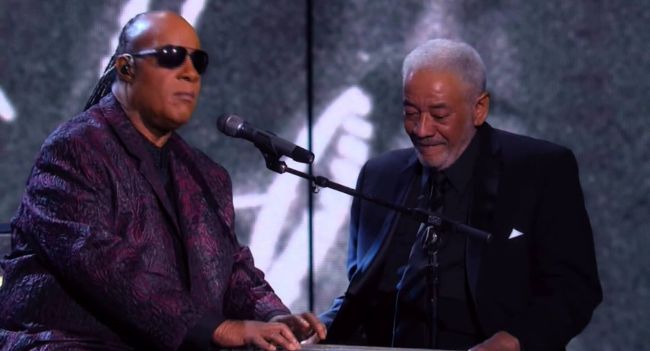Imagine sitting knee to knee with Bill Withers while playing his classic song “Ain’t no Sunshine”. Imagine having Stevie Wonder singing your song right at your side. This is what happened at Bill Withers’ induction into the Rock & Roll Hall of Fame, Cleveland, on 18 April 2015.
Stevie Wonder’s foot tapping performance is as soulful and lyrical as one would expect – he is Stevie Wonder after all. Wonder is particularly impressive when extemporises towards the end. Bill Withers’ expressions show his gratitude, appreciation and joy. His sheer delight as he reaches out to touch Wonder at the conclusion is truly special.
Bill Withers was inducted into the Rock and Roll Hall of Fame “25 years or something” after he stopped performing. As he told Rolling Stone magazine on the night of his induction, he was already in his 30s when he started in the music business. He’d built houses, bought tools and paid for a truck, so he was never tied to the music profession. He said he never really had the personality to be an entertainer as he wasn’t outgoing, he was shy, and he tended to hide behind his guitar.
Of course Withers was invited to play during the induction ceremony, but he declined. This didn’t stop John Legend from calling Withers on stage during Legends’ planned duet on Lean on Me with Stevie Wonder. Legend handed Withers a microphone. Withers later quipped that he pretended to sing behind John Legend. If he was reluctant to sing, Bill Withers stole the show with his funny, honest and inciteful acceptance speech, which is considered one of best in Hall of Fame history. Watch it here:
At the beginning of the first clip, Bill Withers quips “Steve said I could be here to be assistant Harpejji player”. This tells us the name of the unusual instrument that Stevie Wonder plays on his version of “Ain”t no Sunshine”, but what is a Harpejji? Finished in 2008, the Harpejji was the first instrument invented by Tim Meeks of Baltimore.
Meeks describes his invention as a cross between an electric guitar and a piano. It’s on a stand, one sits at it like at a piano, but it’s stringed and fretted. One can tap, slap, bend, slide, strum, ping, pluck or mute the strings. Chord voicings can be more open than on a piano, but tighter than on a guitar and, being an electric instrument, the Harpejji allows one to add a large number of effects. Given that there are 24 strings and 15 frets, it is a very versatile instrument that would be nearly impossible for most musicians to play were it not for the black and white markers (similar to a piano). That Stevie Wonder mastered the instrument despite his blindness is a testament to his musicality.
It is not surprising that Stevie Wonder gravitated to the Harpejji. A multi-instrumentalist who played all of the instruments on many of his albums, Wonder had a particular fondest for the Clavinet, an earlier, but more limited, cross between a piano and an electric guitar. The crisp, funky introductory vamp on Superstition is a classic example of the sound of a Clavinet.
